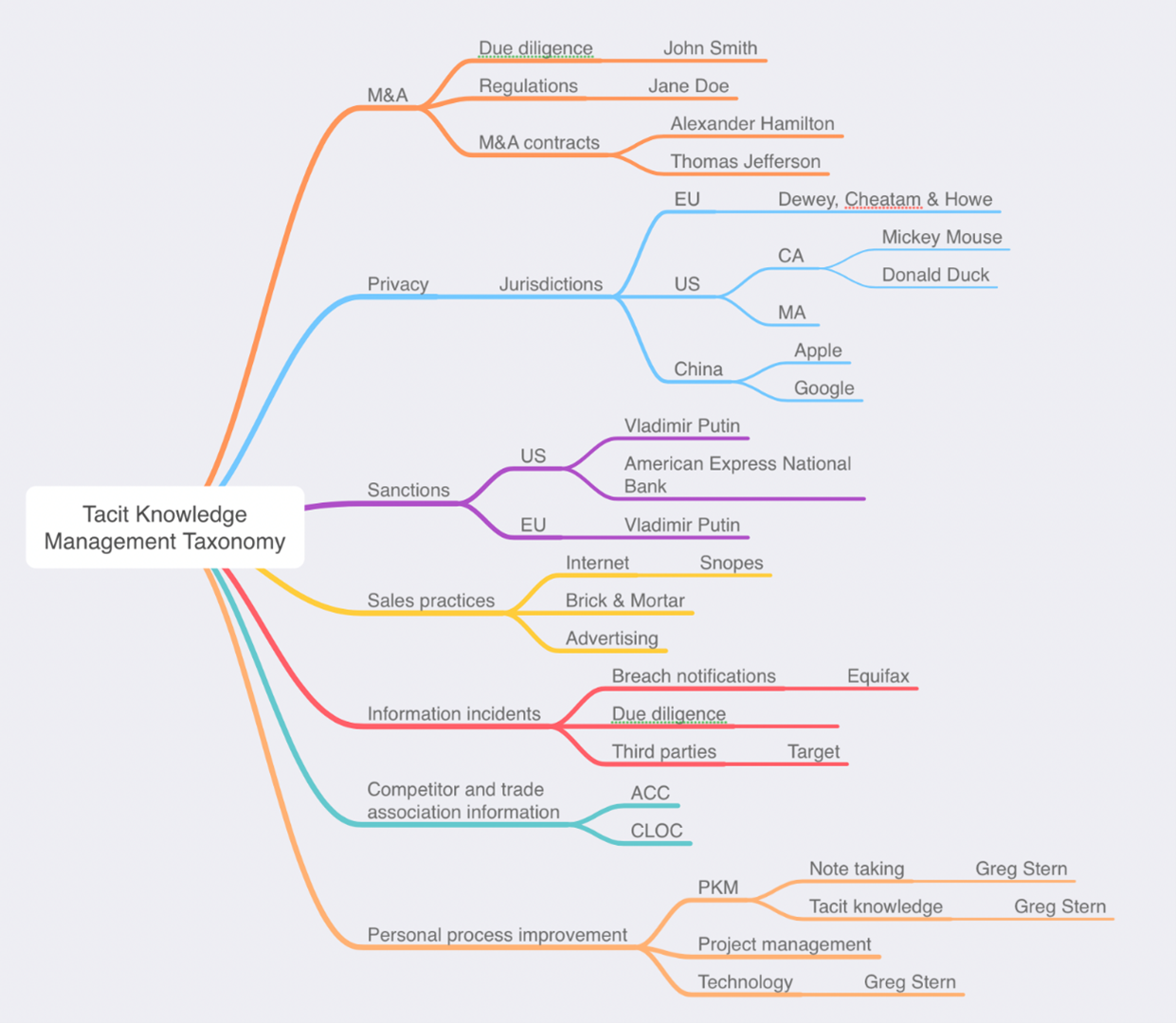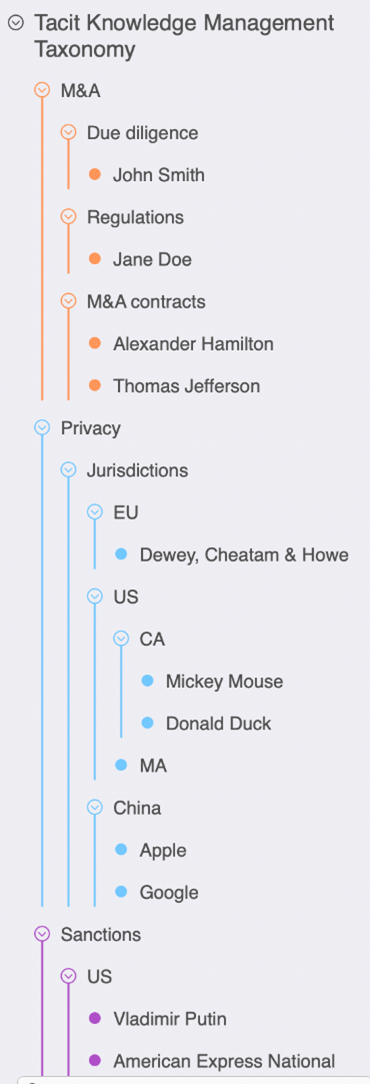VectorMine / Shutterstock.com
Personal knowledge management (KM) systems are a hot topic, but almost all of it is focused on explicit, or recorded knowledge. In this column, I recommend some ways that individual lawyers can develop personal knowledge management systems that also capture tacit knowledge — the knowledge that you or your colleagues have inside your minds, versus the explicit knowledge you may have collected.
Why is this important? At a corporate level, tacit knowledge comprises the vast majority of a company's knowledge assets. It is one of the main forms of any company’s intangible assets, which are estimated to make up 84 percent of the value of all US S&P company assets. In 2019, companies’ intangible assets were estimated to be worth US$21 trillion, three times more than their tangible counterparts. There is, of course, no way to know how much value is contained in your own company’s tacit knowledge, but clearly it could be extraordinarily valuable.
Tacit knowledge management
On a personal knowledge management level, tacit knowledge management may be even more relevant. How often have you admired the way a colleague or outside counsel analyzed a complicated legal issue, had useful experience in a particular type of transaction, conducted a meeting, or demonstrated their note taking or task management prowess, wishing you could do any of those things nearly as well? Those skills are examples of tacit knowledge. And, believe it or not, those are examples of things that would be fairly easy to incorporate into your personal knowledge management system.
And please, do not rely on your ability to recall which colleague or outside counsel knew what. You may have a world class memory, but the way memory retrieval works depends on a complicated mechanism of retrieval cues, and those cues are not only more random than we suppose but are not always intuitive (and therefore readily available), even within our own minds. So, the fact that you discovered that a colleague had special expertise in sanctions law three years ago will not always leap into your mind just when you need it. You should develop reliable outside mechanisms to help.
The lowest hanging fruit involves simply using a tool that nearly everyone already has: your preferred contacts app. Whether it’s based on Microsoft, Apple, Google, or another company, we all use our contacts apps to capture phone numbers, physical, website, and email addresses, and even relationships and birthdays — but they also allow space for notes.
The lowest hanging fruit involves simply using a tool that nearly everyone already has: your preferred contacts app.
The trick is, whenever you happen to find out that a colleague or friend has expertise or background in an area that might be valuable to you, make a note of it in the note field in your contacts app. Those note fields are searchable in every major app, so in the future if you need to find out whether you know someone who has expertise in sanctions law, all you will need to do is search for them.
And, by the way, it isn’t very difficult to develop a shared contacts folder for your entire law department. That way, you could, for example, keep track of which outside counsel has special tacit knowledge that others in your department may need. You can also download most app content into spreadsheets, like Excel, to easily view each field.
Create a mind map
You may decide to become more sophisticated and systematic in organizing your tacit management assets. For example, instead of relying upon chance to find out that your colleagues have some unexpected expertise, you may want to actively search for colleagues with the expertise you may need, even before you actually need it.
How do you start? One way of doing it that I have written before is to develop one or more knowledge taxonomies. In simple terms, this is a mind map or other branching representation of the areas of knowledge you believe will be of use to you. These should include not only legal areas, but also other areas of information that you may find useful, such as the various kinds of business your company conducts, technology systems it uses, competitor and trade association information, etc. It may also include personal process improvement areas in which you are interested.
Here is a simple mind map I created to illustrate the idea. Note that the mind map not only includes a taxonomy of personal and tacit knowledge management areas that a lawyer might find useful in doing their job, but on many of the branches, I have indicated people, companies, or law firms that have expertise in those areas.

Note also that all modern mind map applications allow hyperlinks to be inserted into any node of it. So, for example, you could include a link to a law firm you use, to your contacts entry for that firm, or to a colleague within your company who has worked extensively with them. You can even include a link to a memo or another mind map, if you have one that goes into a particular topic area.
Mind maps are easy to create. I like the app I used for this illustration, which is called MindNode, because it is available on Windows or Mac and also works great on an iPad or other tablet, where you can simply rearrange branches by dragging them around. But there are many good mind mapping applications available.
Another cool thing about mind maps is that most of the good ones are able to export mind maps as OPML files that will automatically convert to outlines in most full featured outline apps. In MindNode, you can also view the mind map and modify it by looking at the included outline feature, which for this mind map looks like this:

Do what works best for you
Obviously, mind maps aren’t the only tool you can use for a tacit knowledge management tool. You could use any spreadsheet app, like Excel, Smartsheet, Numbers or Google Sheets, or a Word doc or a SharePoint instance, etc. The main thing is to develop a system that is easy for you to use and develop a personal knowledge management taxonomy in.
Recruit experts for your company
Once you have developed a taxonomy, it is time to locate experts inside your company or among your outside counsel who have expertise in that area. So, you might decide that you wouldn’t want to have to scramble to find outside counsel experts in data breaches or sanctions after you discover you have a calamity to deal with, so you reach out to your colleagues and outside counsel in advance to locate individuals with that expertise. Then, you can put them in your contacts, spreadsheet, mind map, or other tool of choice so you will be better prepared when you need to tap into it.
Take initiative with your colleagues
When improving your own processes, don’t just compile a list of tacit experts in those areas. Instead, consider interviewing colleagues who seem especially good at personal process improvement areas in which you are interested in learning their best practices. In my experience, people are usually very generous in that respect, and it will give them an opportunity to learn from you as well. Mutual support and sharing should be a part of every law department’s culture. After all, a rising tide lifts all boats.




